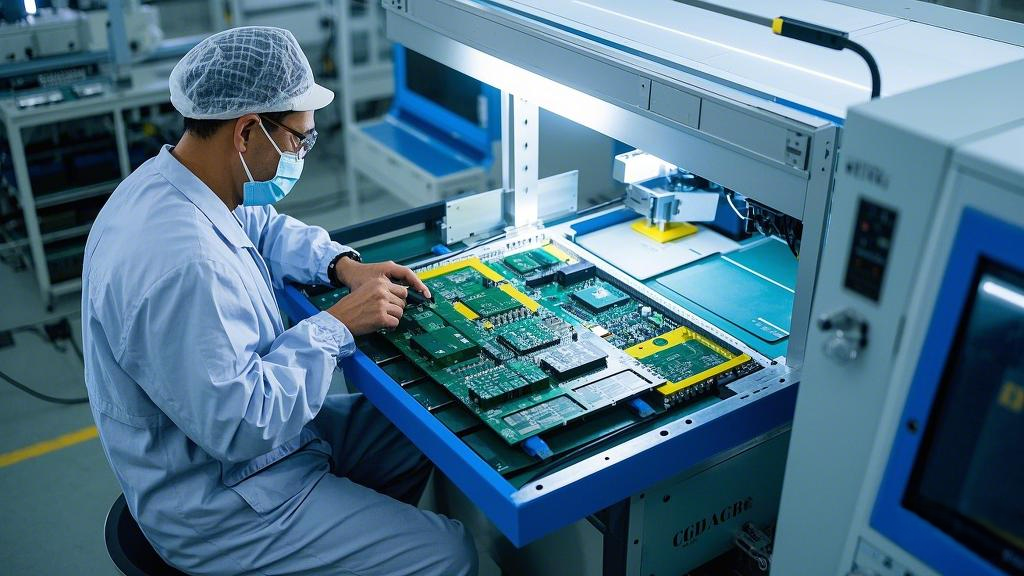Key Takeaways
- EMS vs OEM: EMS provides manufacturing services to OEMs, while OEMs design and manufacture products under their own brand.
- Cost Benefits: EMS eliminates capital investment requirements and significantly reduces overhead costs through optimized processes.
- Scalability: EMS offers flexible, variable cost structures enabling rapid production scaling without fixed capacity constraints.
- Time-to-Market: EMS accelerates product launches by 2-6 months through established processes and parallel development.
- Risk Mitigation: EMS provides supply chain diversification, technology obsolescence protection, and regulatory compliance expertise.
- KINGBROTHER EMS Advantage: 28+ years of experience, no MOQ requirements, quick-turn capabilities, and comprehensive industry certifications.
Introduction
The global Electronics Manufacturing Services (EMS) market is projected to reach $1.4 trillion by 2030, reflecting a fundamental shift toward strategic manufacturing partnerships. For electronic product companies, choosing between EMS and Original Equipment Manufacturer (OEM) models represents an opportunity to optimize costs, accelerate time-to-market, and enhance ROI, with strategic EMS partnerships drastically improving productivity and cost savings while enabling greater focus on core competencies and innovation.
This comprehensive guide examines both manufacturing approaches through an ROI lens, providing business leaders with the framework needed to make informed decisions. We’ll explore how each model handles cost structures, risk management, scalability, and resource allocation, ultimately demonstrating why EMS manufacturing often delivers superior financial returns for modern electronic product companies.

What Does EMS Stand For in Manufacturing?
Electronic Manufacturing Services (EMS) represents a comprehensive outsourcing model where specialized companies handle the entire electronics manufacturing process on behalf of Original Equipment Manufacturers (OEMs). Rather than maintaining in-house production capabilities, companies partner with EMS providers to leverage their manufacturing expertise, equipment, and supply chain networks.
Core EMS Service Components
EMS providers offer an integrated suite of services that covers the complete product lifecycle:
- PCB Assembly and Manufacturing: Advanced printed circuit board design, layout, and assembly services using state-of-the-art equipment. This includes everything from simple single-layer boards to complex multi-layer, high-frequency, and rigid-flex designs.
- Component Sourcing and Supply Chain Management: Leveraging established supplier networks and purchasing power to procure components at competitive prices while ensuring quality and authenticity. EMS providers typically maintain relationships with hundreds of component suppliers worldwide.
- Testing and Quality Assurance: Comprehensive testing protocols including in-circuit testing (ICT), functional testing, automated optical inspection (AOI), and X-ray inspection to ensure product reliability and performance.
- Product Design and Engineering Support: Design for manufacturability (DFM) consultation, value engineering, and technical optimization to improve product performance while reducing manufacturing costs.
Types of EMS Providers
The EMS landscape includes various provider types, each with distinct capabilities and market focus:
- Full-Service EMS vs. Specialized Providers: Full-service providers offer end-to-end solutions from design through final assembly and testing, while specialized providers focus on specific aspects like PCB manufacturing or component sourcing.
- Regional vs. Global EMS Companies: Regional providers offer proximity advantages and faster communication, while global providers deliver scale economies, diverse geographic capabilities, and risk distribution across multiple markets.
EMS Industry Evolution and Market Size
The EMS industry has evolved from simple contract assembly to comprehensive design and manufacturing partnerships. Market growth drivers include increasing product complexity, shorter development cycles, and the need for specialized manufacturing capabilities that many OEMs cannot economically maintain in-house.

What Does OEM Stand For?
Original Equipment Manufacturer (OEM) refers to companies that design and manufacture products sold under their own brand name. In the traditional OEM model, companies maintain comprehensive in-house manufacturing capabilities, controlling every aspect of production from component sourcing through final assembly.
Traditional OEM Manufacturing Model
- In-House Production Capabilities: OEMs invest in manufacturing facilities, equipment, and personnel to produce their products internally. This includes production lines, testing equipment, quality control systems, and specialized manufacturing processes.
- Vertical Integration Approach: OEMs often pursue vertical integration, controlling multiple stages of the supply chain from raw materials through finished products. This approach aims to maximize control over quality, costs, and delivery schedules.
- Capital Investment Requirements: The OEM model demands significant upfront capital investments in manufacturing equipment, facility infrastructure, and skilled personnel. These fixed costs must be amortized across production volumes.
OEM vs Contract Manufacturing Distinctions
While OEMs focus on brand development and market presence, contract manufacturers (including EMS providers) specialize in manufacturing efficiency and process optimization. OEMs retain product design and marketing control while potentially outsourcing production activities.
When OEM Makes Business Sense
- High-Volume Standardized Products: OEMs may achieve economies of scale with high-volume, standardized products where manufacturing processes remain stable over extended periods.
- Proprietary Technology Protection Needs: Companies with highly sensitive intellectual property or unique manufacturing processes may prefer maintaining in-house control to protect competitive advantages.
What is the Difference Between EMS and OEM?
Understanding the fundamental differences between EMS and OEM approaches requires examining multiple dimensions of manufacturing strategy, each with distinct implications for business performance and ROI.
EMS vs OEM
| Factor |
EMS Approach |
OEM Approach |
| Core Focus |
Manufacturing and testing of products |
Design, development, and sale of products under the brand name |
| Initial Capital Investment |
Minimal – leverage the provider’s existing infrastructure |
High – significant equipment and facility investments |
| Variable Cost Structure |
Pay-per-unit pricing with volume discounts |
Fixed costs spread across production volumes |
| Scalability |
Rapid scaling up/down without capital constraints |
Limited by fixed capacity, expensive to scale |
| Time-to-Market |
2-6 months faster due to established processes |
Longer due to setup and learning curves |
| Technology Access |
Immediate access to the latest manufacturing technologies |
Must invest in and maintain technology upgrades |
| Risk Distribution |
Shared risk with manufacturing partner |
Full risk concentration in-house |
| Quality Control |
Leverages the provider’s specialized expertise and certifications |
Direct control but requires internal expertise development |
| Profit Margin |
Average |
High due to branding |
Capital Investment Requirements
EMS: Access world-class manufacturing through service agreements with minimal upfront investment, preserving capital for R&D and marketing.
OEM: Requires millions in equipment, facilities, and tooling investments that create substantial fixed costs.
Supply Chain Management Approaches
EMS: Leverages volume purchasing across multiple clients for superior pricing and supply security, with thousands of supplier relationships for quick alternative sourcing.
OEM: Maintains direct supplier relationships but lacks volume leverage, resulting in higher component costs despite greater control.
Technical Expertise and Resources
EMS: Offers specialized knowledge across diverse technologies (high-frequency design, medical devices, automotive) that would be expensive to develop internally.
OEM: Provides deep product-specific expertise but limited flexibility for new product categories.
How EMS Offers More Benefits to Your Business
The EMS model delivers compelling advantages that translate directly into improved financial performance and strategic flexibility for electronic product companies.
Cost Advantages and ROI Improvements
- Significant Cost Reduction: Companies typically achieve substantial cost savings by eliminating fixed manufacturing overhead, accessing volume purchasing discounts, and leveraging manufacturing efficiency improvements.
- Zero Capital Equipment Investment: Avoid tying up capital in manufacturing equipment that may become obsolete or require expensive upgrades.
- Reduced Overhead: Eliminate specialized manufacturing personnel, facility overhead, and associated benefits costs.
Enhanced Flexibility and Scalability
- Variable Cost Structure: Scale production up or down quickly without fixed capacity constraints or idle equipment costs.
- Latest Technology Access: Gain immediate access to cutting-edge manufacturing equipment and processes without individual investments.
- Geographic Flexibility: Optimize production location based on cost, market proximity, or supply chain considerations.
Accelerated Time-to-Market
- Faster Product Launches: Established manufacturing processes and qualified supplier networks enable much quicker new product introductions.
- Parallel Processing: Manufacturing preparation can begin while product development continues, compressing overall time-to-market.
- Rapid Prototyping: Quick-turn prototyping services enable faster design iterations and shorter development cycles.
Risk Mitigation Benefits
- Technology Obsolescence Protection: EMS providers spread technology investment costs across multiple clients and continuously upgrade equipment.
- Supply Chain Diversification: Diverse supplier networks and alternative sourcing strategies reduce vulnerability to component shortages.
- Regulatory Compliance: Specialized providers maintain industry-specific certifications and regulatory expertise.
- Global Presence: Many EMS providers have a global reach, facilitating easier access to international markets.
Focus on Core Competencies
- Resource Optimization: Concentrate engineering resources on innovation and product development rather than manufacturing processes.
- Market Expansion: Redirect capital and management resources toward customer acquisition and brand building.
- Innovation Investment: Improved cash flow enables greater investment in R&D activities that drive competitive advantage.
KINGBROTHER’s EMS Solutions
KINGBROTHER exemplifies the modern EMS manufacturing company, offering comprehensive manufacturing solutions that deliver measurable ROI improvements for electronic product companies across diverse industries.
Comprehensive EMS Service Portfolio
- PCB Design and Layout Services: Expert PCB design optimization for manufacturability, typically reducing production costs by 15-25% compared to non-optimized designs.
- Advanced Manufacturing Capabilities: Specialized expertise in HDI, rigid-flex, and high-frequency PCBs with technical capabilities including:
- Layer counts up to 68 layers
- Line widths down to 2.0 mils
- Copper thickness up to 18 OZ
- Component Sourcing and BOM Optimization: Leveraging relationships with over 500 suppliers worldwide, typically reducing component costs by 10-20% through optimization and volume purchasing.
- Quality Testing and Certification: Comprehensive testing capabilities including AOI, ICT, functional testing, and environmental testing.
Industry-Specific EMS Expertise
- Medical Device Manufacturing: ISO 13485 certification with deep FDA regulatory understanding.
- Telecommunications and 5G Infrastructure: High-frequency and high-speed design expertise.
- Industrial Control and Automation: Robust designs for harsh environments with strict durability requirements.
- AI and IoT Device Production: Miniaturized designs and flexible PCB capabilities for connected devices.
KINGBROTHER’s Competitive Advantages
- 28+ Years of Experience: Deep manufacturing knowledge across diverse industries since 1997.
- No MOQ Requirements: Exceptional flexibility for prototypes, low-volume products, and market testing.
- Quick-Turn Capabilities: 24-48 hour options for prototypes and expedited production.
- Global Supply Chain Network: Multiple design centers and manufacturing facilities across regions.
Cost Optimization Strategies
- Design for Manufacturability (DFM): Optimize designs for efficiency, typically reducing production costs by 20-30%.
- Value Engineering: Systematic analysis to reduce costs while maintaining or improving performance.
- Supply Chain Cost Analysis: Detailed cost analysis and alternative component recommendations.
Quality and Compliance Standards
- Comprehensive Certifications: ISO 9001, ISO 14001, and ISO 13485 certifications.
- Advanced Testing: Sophisticated equipment and protocols ensure products meet quality requirements.
- Complete Traceability: Full traceability from component sourcing through final assembly for regulatory compliance.
Choose KINGBROTHER’s EMS to Get Better ROI
EMS partnerships deliver superior ROI for electronic product companies by eliminating capital investments, providing access to world-class manufacturing capabilities, and enabling rapid scaling. KINGBROTHER’s comprehensive EMS solutions — backed by 28+ years of experience, industry-specific expertise, and flexible manufacturing capabilities — will allow clients to focus on innovation and market growth while ensuring manufacturing excellence.
Ready to optimize your manufacturing strategy? Contact us today to discover how our EMS electronic manufacturing services can accelerate your product development and reduce costs.

